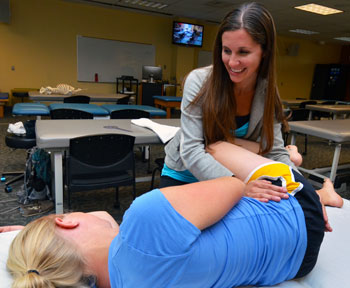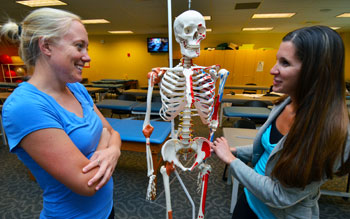Opening Doors and Improving Education
Student Who Is Blind at Home in PT Program
By Mark Couch
 Lugging 30 pounds of Braille paper around the Anschutz Medical Campus is not the ideal way to learn physical therapy
Lugging 30 pounds of Braille paper around the Anschutz Medical Campus is not the ideal way to learn physical therapy
With a rare eye condition that causes blindness, Townsend-Cobb already faces a challenge unlike any of her classmates; there’s no need to add cross-campus weightlifting to the curriculum, so the school is making a digital version that Townsend-Cobb’s computer can read.
“My disability is forcing the education system to do what’s nicer for everybody,” Townsend-Cobb says. “Thank
The Americans with Disabilities Act (ADA), a landmark federal law originally passed in 1990, opens doors for those with physical impairments. At the School of Medicine, that means providing a learning environment that makes a reasonable effort to meet the needs of students
“The nature of the content can make it difficult,” Özi says, “because it includes 3-D images.”
Reading documents in a nontraditional format
EKG.
Townsend-Cobb, 23, was diagnosed with retinitis pigmentosa when she was 3 years old. By the time she was in high school her vision loss became “what I would call a disability,” she says. The disease, an inherited eye disorder, leads to blindness as photoreceptor cells in the eyes die. The loss of sight is gradual and narrows the person’s field of vision.
“For some
Townsend-Cobb grew up in Ormond Beach, Fla., where her father runs a seafood restaurant and her mother is a nurse. She has three siblings, including a younger sister who also has retinitis pigmentosa
 “My mom went to battle for us,” Townsend-Cobb says. “She saw too well what we were going to need in school and she had to fight hard to convince people. She started a statewide program to help parents of children with visual impairments.”
“My mom went to battle for us,” Townsend-Cobb says. “She saw too well what we were going to need in school and she had to fight hard to convince people. She started a statewide program to help parents of children with visual impairments.”
Townsend-Cobb credits her family for giving her a positive approach that transcends studies and classroom materials and focuses on pursuing dreams, whatever they may be.
“It’s easy to get to a dark place,” Townsend-Cobb says. “My mom never let us have that attitude.”
Growing up, Townsend-Cobb played soccer. She has rafted through the Grand Canyon where she saw “pink stripes” on the canyon walls. Last summer, she set off to Telluride for a few days to participate in a “No Barriers Summit” where participants engage in hiking, climbing, painting and other activities.
“I joke with her, ‘I don’t think you realize you are blind,’” Özi says. “She is tremendously independent. She is getting everywhere and finding everything on her own.”
There are challenges to overcome. When treating a patient, Townsend-Cobb can touch and listen, but she acknowledges that sometimes seeing is necessary.
“I’ve become better at listening,” she says. “I can feel the inflammation or texture change. And if it’s something I need to see, I’ll step outside the door and ask for a tech. While some of my classmates might use tech or aide to get a towel, I’ll grab their eyes for a second.”
In class, Townsend-Cobb also jumps at chances to serve as the patient. It allows her to feel the process as a skilled professional goes through the steps of diagnosing a condition.
“I didn’t want to go somewhere because they had to accept me because of the ADA,” she says. “I wanted to go somewhere because they wanted me to go there, and that’s how they made me feel here. An impairment is a condition of the body, like a tight hamstring. A disability is what society makes of an impairment. I don’t feel disabled in school.”